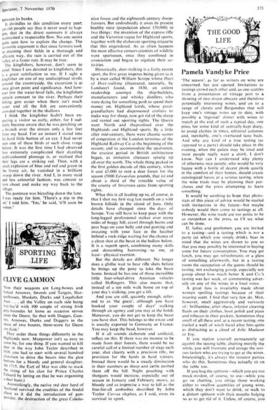CLIVE GAMMON
Now their weapons are Long-bowes and forked Arrowes, Swords and Targets, Ear- quebusses, Muskets, Durks and Loquhabor Axes. . . all the Valley on each side being way-lay'd with 100 couple of strong Irish grey-houndes let loose as occasion serves Von the Deere. So that with Dogges, Gun- yes, Arrowes, Durks and Daggers in the Space of two houres, three-score fat Deere are slain.'
They order these things differently in the Highlands now. Manpower isn't so easy to come by, for one thing. If you wanted to kill deer in the way John Taylor described in 1618, you had to start with several hundred clansmen to drive the beasts into the glen bottom for a bloody and general slaughter. lln 1715, the Earl of Mar was able to mask the rising of his clan for Prince Charles Edward by letting on that he was organising a deer hunt.)
Astonishingly, the native red deer herd of Scotland survived the crudities of the feudal chase as it did the introduction of gun- 1)°wder. the destruction of the great Caledo-
nian forest and the eighteenth century sheep- farmers. But undoubtedly it owes its present healthy state (population about 150,000) to two things: the invention of the express rifle and the Victorian vogue for Highland sports, together with the elaborate sporting etiquette that this engendered. As so often happens the most effective conservationists of wildlife were sportsmen, once they combined in association and began to regulate their ac- tivities.
Historically, deer-stalking is a fairly recent sport, the first great impetus being given to it by a man called William Scrope whose Days of Deer-stalking (illustrated, naturally, by Landseer) found, in 1830, an ardent readership amongst the ship-builders, manufacturers and whisky distillers who were dying for something posh to spend their money on. Highland lairds, whose great- grandfathers had dispossessed crofters to make way for sheep, now got rid of the sheep and rented out sporting rights. The Queen went North and rhapsodised over the Highlands and Highland sports. By a little after mid-century, there were chaotic scenes of congestion at the London terminus of the Highland Railway Co at the beginning of the season; and to accommodate the sportsmen, the craziest period in British architecture began, as imitation chateaux sprang up all over the north. The whole thing peaked in the first golden decade of this century, when it cost £5,000 to rent a deer forest for the season (5000 Edwardian pounds, that is) and about a third of the rateable value of the county of Inverness came from sporting rights.
What this is all leading up to, of course, is that I shot my first stag last month on a wild brown hillside in the island of Jura. Only details have changed since the days of Scrope. You still have to keep pace with the long-legged professional stalker over many miles of boggy hill, crawl through burns and peat hags on your belly and end panting and sweating with your face in the heather behind a rock-ridge waiting for the chance of a clean shot at the beast in the hollow below. It is a superb sport, combining many skills and demanding harrowing—to me, at least—physical exertion.
But the details are different. No longer does a ghillie wait to hear rifle shots before he brings up the pony to take the beast home. Instead he has one of those incredible little four-wheel-drive Austrian vehicles called Haflingers. This also means that, instead of a ten mile walk home on top of your day's stalking, you get a lift.
And you are still, quaintly enough, refer- red to as 'the guest', although you have booked your couple of days' stalking through an agency and you stay at the hotel: Moreover, you do not get to keep the beast you have shot. This belongs to the estate and is usually exported to Germany or France. You may keep the head, however.
If it all sounds elaborate and artificial, reflect on this. If there was no income to be made from deer forests, there would be no careful cull of a limited number of stags each year, shot cleanly with a precision rifle, no provision for the herds in hard winters. Instead there would be a steady dimibution in their numbers as sheep and cattle pushed them off the hill. Night poaching with shotguns would increase, especially out of season in January and February snows, as bloody and as imprecise a way to kill as the free-for-all ambushes described by John Taylor. Cervus elephus, as I said, owes its survival to sport.






















































 Previous page
Previous page